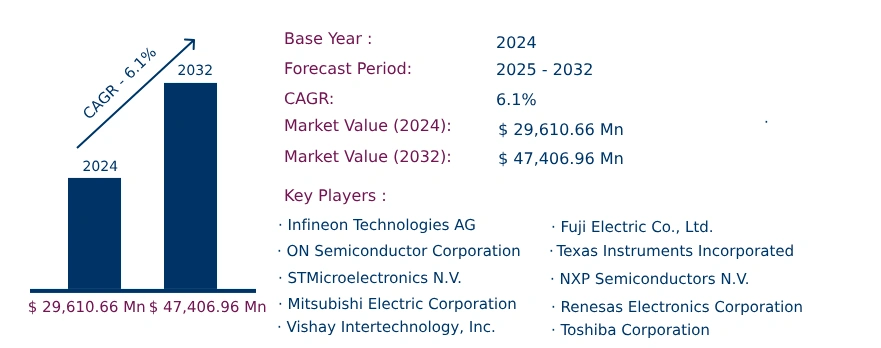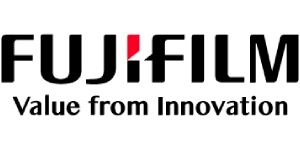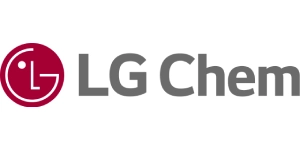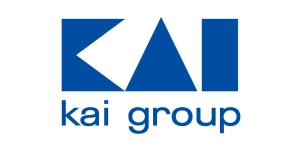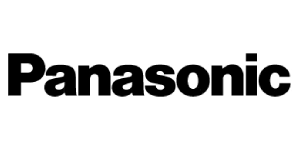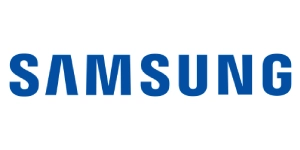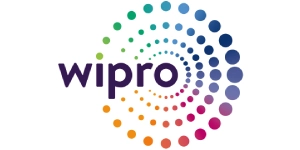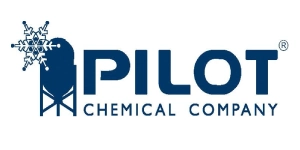Global Power Electronics Market to Reach USD 47,406.96 Million by 2032 | CAGR of 6.1%
Category : Semiconductor And Electronics | Published Date : Jan 2025 | Type : Press Release
Power Electronics Market Scope & Overview:
As per the Consegic Business Intelligence newly published report, the Power Electronics Market is projected to grow from USD 29,610.66 million in 2024 to USD 47,406.96 million by 2032, at a CAGR of 6.1% during the forecast period. Power electronics refers to the control, conversion, and management of electrical power using semiconductor devices, ensuring efficient energy conversion in various applications. These technologies play a critical role in industries such as automotive, renewable energy, consumer electronics, and industrial automation.
The market consists of inverters, converters, rectifiers, and power management integrated circuits (PMICs), designed for high efficiency and compact integration. These systems support advanced functionalities like energy savings, precise control, and compatibility with modern digital infrastructure. Power electronics is widely integrated into electric vehicles (EVs), renewable energy sources, smart grids, and industrial power management systems, making them essential for optimizing energy consumption.
The report comprises the Power Electronics Market Share, Size & Industry Analysis, based on Device Type (Power Discrete Devices, Power Modules, Power ICs), Component (Thyristors, Gate Turn-Off Transistors, MCTs, Silicon Controlled Rectifiers, AC/AD Converters, Static Switches, MOSFETs, Others), Material (Silicon, Silicon Carbide, Gallium Nitride, Others), End-User Industry (Automotive, IT & Telecom, Energy & Utilities, Aerospace & Defense, Industrial Manufacturing, Others), and Region (North America, Europe, Asia-Pacific, Latin America, Middle East & Africa), and Forecast, 2025-2032.
The report contains detailed information on Power Electronics Market Trends, Opportunities, Value, Growth Rate, Segmentation, Geographical Coverage, Company Profiles, In-depth Expert Analysis, Revenue Forecast, Competitive Landscape, Growth Factors, Restraints or Challenges, Environment & Regulatory Landscape, PESTLE Analysis, PORTER Analysis, Key Technology Landscape, Value Chain Analysis, and Cost Analysis.
Advancements in semiconductor materials, such as silicon carbide and gallium nitride, are driving market expansion by enhancing energy efficiency and thermal performance in high-power applications. Growing adoption of electric vehicles and renewable energy systems is creating lucrative opportunities for power electronics, with governments worldwide supporting clean energy initiatives and smart grid infrastructure.
Segmental Analysis :
Based on device type, the market is segmented into Power Discrete Devices, Power Modules, and Power ICs.
- The power discrete devices segment accounted for the largest market share of 48.5% in 2024, driven by widespread use in automotive, industrial manufacturing, and renewable energy systems due to their cost-effectiveness and reliability in handling voltage and current levels.
- The power modules segment is anticipated to grow at the fastest CAGR, supported by their high integration, compact design, and increasing adoption in electric vehicles and renewable energy systems, particularly in inverters and converters.
Based on component, the market is segmented into Thyristors, Gate Turn-Off Transistors, MCTs, Silicon Controlled Rectifiers, AC/AD Converters, Static Switches, MOSFETs, and Others.
- The MOSFET segment dominated the market in 2024 due to its efficiency and widespread applications in automotive, IT & telecom, and industrial sectors. MOSFETs are essential for high-speed switching, power conversion, and battery management in electric vehicles.
- The silicon controlled rectifiers (SCRs) segment is projected to register the highest CAGR, driven by increasing demand in high-voltage industrial drives, power distribution infrastructure, and smart grid projects.
Based on material, the market is segmented into Silicon, Silicon Carbide, Gallium Nitride, and Others.
- The silicon segment held the largest revenue share in 2024, attributed to its affordability, high availability, and well-established manufacturing processes for consumer electronics, automotive, and industrial applications.
- The silicon carbide (SiC) segment is projected to grow at the fastest rate, driven by higher efficiency, superior thermal performance, and increasing adoption in electric vehicles and renewable energy systems.
Based on end-user industry, the market is segmented into Automotive, IT & Telecom, Energy & Utilities, Aerospace & Defense, Industrial Manufacturing, and Others.
- The automotive segment accounted for the largest market share in 2024, propelled by rising demand for electric and hybrid vehicles and the increasing use of power electronics in energy distribution and battery efficiency improvement.
- The energy & utilities segment is expected to witness the fastest CAGR, driven by integration of renewable energy systems, smart grid adoption, and government policies promoting clean energy solutions.
Based on regions, the market is segmented into North America, Europe, Asia-Pacific, Middle East and Africa, and Latin America.
- Asia-Pacific led the market in 2024, valued at USD 8,720.59 million, with China accounting for 31.6% of the regional revenue. The region’s dominance is attributed to rapid industrialization, urbanization, and the increasing adoption of power electronics in consumer electronics, automotive, and renewable energy sectors.
- North America is expected to reach USD 15,364.60 million by 2032, driven by expansion of renewable energy projects and increasing EV adoption. The region’s focus on smart grid infrastructure and energy storage solutions further boosts demand for power electronics.
| Report Attributes | Report Details |
| Study Timeline | 2019-2032 |
| Market Size in 2032 | USD 47,406.96 Million |
| CAGR (2025-2032) | 6.1% |
| Device Type | Power Discrete Devices, Power Modules, Power ICs |
| Component | Thyristors, Gate Turn-Off Transistors, MCTs, Silicon Controlled Rectifiers, AC/AD Converters, Static Switches, MOSFETs, Others |
| Material | Silicon, Silicon Carbide, Gallium Nitride, Others |
| End-User Industry | Automotive, IT & Telecom, Energy & Utilities, Aerospace & Defense, Industrial Manufacturing, Others |
| By Region | North America(U.S., Canada, Mexico) Europe(U.K., Germany, France, Spain, Italy, Russia, Benelux, Rest of Europe) APAC(China, South Korea, Japan, India, Australia, ASEAN, Rest of Asia-Pacific) Middle East & Africa(GCC, Turkey, South Africa, Rest of MEA) LATAM(Brazil, Argentina, Chile, Rest of LATAM) |
Top Key Players & Competitive Landscape :
The competitive landscape encompasses major innovators, aftermarket service providers, industry giants, and niche players, all of which are thoroughly examined by Consegic Business Intelligence in terms of their strengths, weaknesses, and value-addition potential. This report includes detailed profiles of key players, market share analysis, mergers and acquisitions, resulting market fragmentation, and emerging partnership trends and dynamics.
List of prominent players in the Power Electronics Industry:
- Infineon Technologies AG (Germany)
- ON Semiconductor Corporation (USA)
- STMicroelectronics N.V. (Switzerland)
- Mitsubishi Electric Corporation (Japan)
- Vishay Intertechnology, Inc. (USA)
- Fuji Electric Co., Ltd. (Japan)
- Texas Instruments Incorporated (USA)
- NXP Semiconductors N.V. (Netherlands)
- Renesas Electronics Corporation (Japan)
- Toshiba Corporation (Japan)
Recent Industry Developments :
- January 2025: Turntide Technologies launched a new series of power electronics and axial flux motors for India's EV market. The Gen 4, 5, and 6 series inverters offer high-efficiency solutions for two-wheelers, three-wheelers, and hybrid vehicles, supporting the "Make in India" initiative.
- November 2024: Valeo and ROHM Semiconductor collaborated to develop next-generation power modules for electric motor inverters, integrating ROHM’s 2-in-1 Silicon Carbide (SiC) TRCDRIVE pack™ to enhance energy efficiency and thermal management in electric vehicles.
